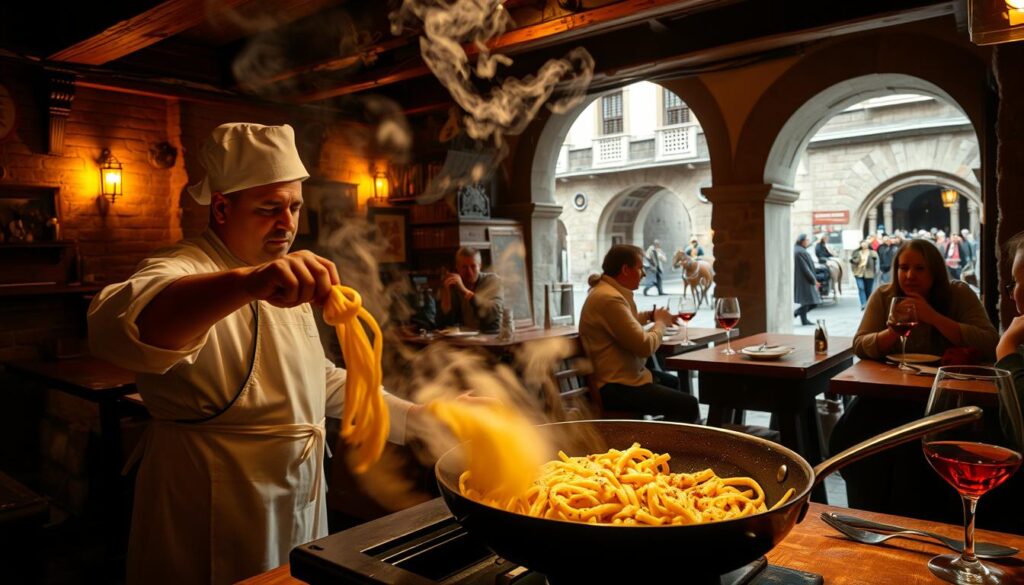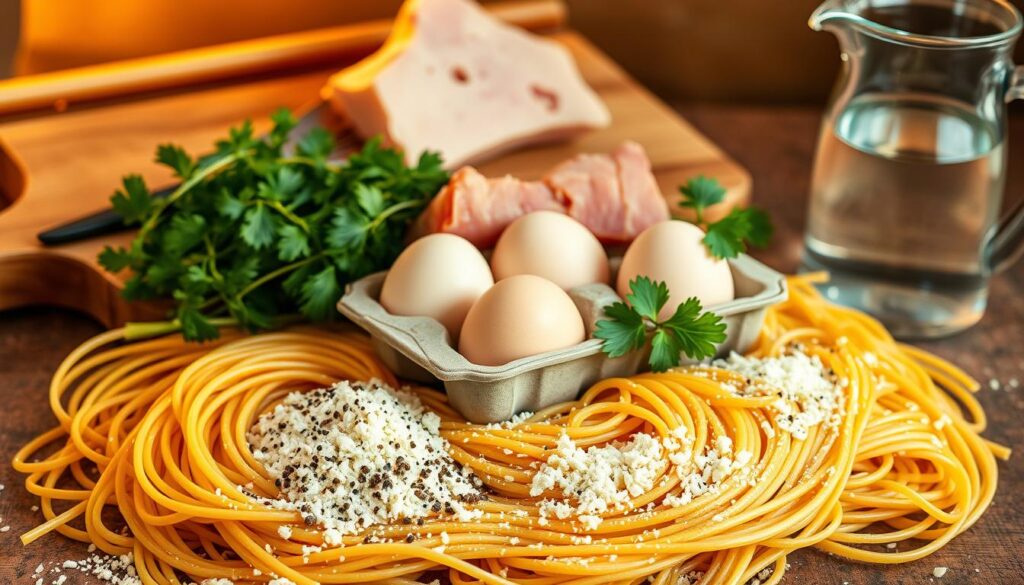Discover the ultimate spaghetti carbonara recipe that brings authentic Italian carbonara straight to your kitchen. This classic Roman dish transforms simple ingredients into a creamy, luxurious meal. It will transport you to the streets of Italy with every bite.
Your journey into authentic Italian carbonara begins with understanding the delicate balance of flavors and techniques. Prepare to master a recipe that combines rich eggs, crispy pork, and perfectly cooked pasta in just 35 minutes.
Key Takeaways
- Authentic carbonara requires no cream
- Total preparation time is approximately 35 minutes
- Perfect for 4 servings
- Uses simple, high-quality ingredients
- Balances rich egg sauce with crispy pork
- Originates from traditional Roman cuisine
The History Behind Classic Roman Carbonara
Spaghetti carbonara is a journey through Italian food history. It started in the mid-20th century, linked to Rome’s post-war food scene. The authentic Italian carbonara came to life during a time of big change in Italian cooking.

The story of carbonara is full of mystery. Food experts have a few interesting ideas about how it began:
- Some think it started during World War II
- American soldiers might have inspired the mix
- Roman cooks used what they had to create it
Origins in Post-War Rome
In post-war Rome, guanciale bacon carbonara was born. It likely came from cacio e uova, a simple pasta dish. By 1950, “carbonara” was first written down, marking its start in cooking.
Evolution of the Recipe
Traditional carbonara is simple. The first recipe was in a Chicago cookbook in 1952. Then, the first Italian recipe was in La Cucina Italiana magazine in 1954.
Traditional vs Modern Interpretations
“Carbonara is not just a dish, it’s a story of survival and creativity” – Roman Chef
Today, many recipes stray from the original. While real carbonara uses guanciale, pecorino romano, eggs, and black pepper, modern versions might add cream or different meats. To truly experience carbonara, stick to its Roman roots.
Essential Ingredients for Authentic Carbonara

Making the perfect egg yolk carbonara sauce needs top-notch ingredients. This classic Roman dish is all about simplicity and balance. It’s made with just a few key ingredients.
Here’s what you need for authentic carbonara:
- 400g (14 oz) of premium spaghetti
- 175g (6 oz) of fresh guanciale
- 2 large whole eggs
- 2 additional egg yolks
- 100g (3.5 oz) of pecorino romano cheese pasta topping
- Freshly ground black pepper
The pecorino romano cheese is key for that authentic Roman taste. It’s salty and tangy, making carbonara unique. Unlike creamy sauces, carbonara gets its richness from egg yolks.
Pro tip: Always use freshly grated pecorino romano for the most intense flavor and best texture.
Quality is important when picking your ingredients. Go for artisanal guanciale and fresh eggs. These are crucial for the sauce’s creamy, luxurious feel.
Ultimate Spaghetti Carbonara Recipe
Making easy homemade carbonara pasta is easier than you think. This ultimate spaghetti carbonara recipe turns your kitchen into a Roman trattoria. It uses just a few key ingredients and techniques.
Impress your dinner guests with this classic Italian pasta. It has rich flavors and a creamy texture. The secret to this dish is its simplicity and precise steps.
Prep Time and Servings
- Total Preparation Time: 35 minutes
- Cooking Time: 20 minutes
- Servings: 4 people
- Difficulty Level: Intermediate
Required Kitchen Tools
- Large pasta pot (6 quarts)
- Wooden spoon
- Large mixing bowl
- Grater for cheese
- Skillet for guanciale
Ingredient Measurements
For your ultimate spaghetti carbonara recipe, you’ll need:
- 1 pound spaghetti
- 4 ounces guanciale (or pancetta)
- 3 large eggs plus 1 egg yolk
- 3/4 cup Parmigiano-Reggiano
- 1/4 cup Pecorino Romano
- 2 tablespoons kosher salt
- Freshly ground black pepper
This easy homemade carbonara pasta recipe combines traditional techniques with simple cooking methods. The secret is in the details. Use room temperature eggs, freshly grated cheese, and control the temperature. This will make your carbonara truly special.
Mastering the Guanciale or Bacon Preparation
Starting an authentic Italian carbonara means picking and preparing the right pork. Your choice between guanciale and bacon greatly affects the dish’s taste.
Traditional Roman recipes call for guanciale, a cured pork cheek. This ingredient gives a richer, more intense flavor than regular bacon. For a true Italian carbonara, guanciale is the best choice.
Choosing Your Meat
When picking your pork, keep these points in mind:
- Authenticity: Guanciale offers the most traditional flavor
- Availability: Thick-cut, unsmoked bacon is a great substitute
- Fat content: Choose cuts with visible fat marbling
Perfect Cooking Techniques
To get crispy, tasty meat for your carbonara:
- Start with a cold pan to slowly render fat
- Cook on medium heat for 8-10 minutes
- Cut guanciale or bacon into large, visible chunks
- Cook until golden and crispy
Pro tip: The meat should be cooked until it releases its natural fat. This creates a tasty base for your authentic Italian carbonara sauce.
The Secret to Creamy Egg Sauce
Making the perfect egg yolk carbonara sauce is an art. It turns simple ingredients into a luxurious dish. The secret is in the balance of eggs and technique.
Your egg sauce success depends on a few key factors:
- Use a higher ratio of egg yolks to whole eggs (2:1 recommended)
- Select fresh, high-quality pasture-raised eggs
- Master the temperature control to prevent scrambling
The magic of egg yolk carbonara sauce comes from tempering the eggs. Start by whisking your egg yolks and whole eggs in a large bowl. The secret is adding hot pasta water slowly. This creates a silky, emulsified sauce without cream.
Professional chefs suggest these techniques:
- Remove the pasta from heat before mixing eggs
- Add one ladle of hot pasta water to the egg mixture
- Quickly toss pasta to coat evenly
Your goal is to make a velvety smooth sauce that sticks to each pasta strand. With practice and patience, you’ll master this authentic Roman technique. You’ll get a creamy carbonara without cream.
Proper Pasta Cooking Techniques
Mastering pasta cooking is key to making authentic Italian carbonara. The first step is to learn how to cook spaghetti perfectly.
Cooking pasta for carbonara needs precision and focus. Your aim is to get the perfect al dente texture. This will make your carbonara truly exceptional.
Al Dente Perfection
To achieve al dente perfection, follow these steps:
- Use 10 cups of water for 1 pound of spaghetti
- Add 1 tablespoon of kosher salt to the water
- Cook spaghetti for about 8-10 minutes
- Test pasta by biting into a strand – it should have a slight resistance
Pasta Water Management
The secret to a creamy sauce is managing pasta water. Chefs suggest saving 3/4 cup of starchy pasta water. This helps make the sauce silky and smooth.
- Save 1/2 cup of pasta water initially
- Keep 2-4 additional tablespoons for sauce consistency
- Use room-temperature water for best results
- Add water gradually while mixing sauce
By using these techniques, you’ll make your homemade carbonara pasta taste like it’s from a restaurant. It will truly capture the essence of authentic Italian carbonara.
Combining Ingredients: Critical Timing and Temperature
Creating the perfect spaghetti carbonara is all about timing and temperature. It’s about mixing hot pasta with an egg mixture just right. This is how you get a creamy carbonara without using cream.
Timing is everything. Take the pasta off the heat fast to avoid scrambled eggs. Here’s how to do it right:
- Transfer hot pasta to a room temperature bowl
- Add egg and cheese mixture immediately
- Toss rapidly to coat every pasta strand
- Use reserved pasta water to adjust sauce consistency
Keeping the temperature right is key. The pasta and guanciale fat’s heat will cook the eggs softly. Aim for a temperature around 70-80°C to prevent curdling.
Save about 1/2 cup of pasta water, as chefs suggest. This starchy liquid makes the sauce smooth and glossy. It coats each spaghetti strand beautifully.
The secret to a perfect carbonara is speed and heat management.
By using these exact methods, you’ll make a top-notch spaghetti carbonara. It will impress everyone who tries it.
Common Mistakes to Avoid
Making easy homemade carbonara pasta can be tricky, even for experts. Knowing common mistakes helps you make it perfect every time.
When making authentic Italian carbonara, some mistakes can ruin the sauce. Cold ingredients and wrong mixing methods often cause problems.
Preventing Scrambled Eggs
Egg temperature is key for a smooth sauce. Here’s how to avoid scrambled eggs:
- Use room temperature eggs for even heat
- Whisk eggs well to avoid streaks
- Turn off the heat before adding eggs
- Slowly mix sauce into hot noodles
Sauce Consistency Tips
Getting the sauce right needs precision and skill. Here are some tips:
- Use whole eggs and extra yolks for richness
- Save one cup of pasta water for adjusting the sauce
- Mix in a large, shallow bowl
- Let pasta heat gently set the eggs
Pro tip: Don’t worry if your sauce looks a bit off. Authentic Italian carbonara is all about flavor, not looks.
With practice, you’ll get the hang of making creamy, delicious homemade carbonara. It will taste just like traditional Roman cuisine.
Serving and Presentation Tips
Timing is key when making the ultimate spaghetti carbonara. Serve it right after cooking to keep its creamy texture and bright flavors. Each bite should be smooth and delicious.
Garnishing is important for a great look. Sprinkle extra Pecorino Romano cheese on top. It should melt a bit into the pasta. Add lots of freshly ground black pepper for a classic Roman touch.
How much you serve matters. Aim for 100-120 grams per person. This way, everyone gets a good-sized meal. Pair it with a crisp white wine like Pinot Grigio to balance the richness.
Carbonara is best eaten right away. Storing it or reheating can ruin the sauce. Make just enough for your meal and enjoy every creamy bite.

